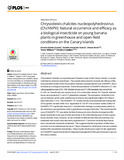Chrysodeixis chalcites nucleopolyhedrovirus (ChchNPV): natural occurrence and efficacy as a biological insecticide on young banana plants in greenhouse and open-field conditions on the Canary Islands
Fecha
2017Autor
Versión
Acceso abierto / Sarbide irekia
Tipo
Artículo / Artikulua
Versión
Versión publicada / Argitaratu den bertsioa
Impacto
|
|
10.1371/journal.pone.0181384
Resumen
Chrysodeixis chalcites, an important pest of banana crops on the Canary Islands, is usually
controlled by chemical insecticides. The present study aimed to evaluate the efficacy of the
most prevalent isolate of the Chrysodeixis chalcites nucleopolyhedrovirus (ChchNPV, Baculoviridae)
as a biological insecticide. Overall the prevalence of ChchNPV infection in C. chalcites
populations was 2.3% ( ...
[++]
Chrysodeixis chalcites, an important pest of banana crops on the Canary Islands, is usually
controlled by chemical insecticides. The present study aimed to evaluate the efficacy of the
most prevalent isolate of the Chrysodeixis chalcites nucleopolyhedrovirus (ChchNPV, Baculoviridae)
as a biological insecticide. Overall the prevalence of ChchNPV infection in C. chalcites
populations was 2.3% (103 infected larvae out of 4,438 sampled), but varied from
0±4.8% on Tenerife and was usually low (0±2%) on the other islands. On Tenerife, infected
larvae were present at 11 out of 17 plantations sampled. The prevalence of infection in larvae
on bananas grown under greenhouse structures was significantly higher (3%) than in
open-field sites (1.4%). The ChchNPV-TF1 isolate was the most abundant and widespread
of four genetic variants of the virus. Application of 1.0x109 viral occlusion bodies (OBs)/l of
ChchNPV-TF1 significantly reduced C. chalcites foliar damage in young banana plants as
did commonly used pesticides, both in greenhouse and open-field sites. The insecticidal efficacy
of ChchNPV-TF1 was similar to that of indoxacarb and a Bacillus thuringiensis (Bt)-
based insecticide in one year of trials and similar to Bt in the following year of trails in greenhouse
and field crops. However, larvae collected at different time intervals following virus
treatments and reared in the laboratory experienced 2±7 fold more mortality than insects
from conventional insecticide treatments. This suggests that the acquisition of lethal dose
occurred over an extended period (up to 7 days) compared to a brief peak in larvae on plants
treated with conventional insecticides. These results should prove useful for the registration
of a ChchNPV-based insecticide for integrated management of this pest in banana crops on
the Canary Islands. [--]
Materias
Chrysodeixis chalcites nucleopolyhedrovirus (ChchNPV),
Banana plants,
Biological insecticides,
Canary islands
Editor
Public Library of Science
Publicado en
Plos One, 12(7): e0181384.
Departamento
Universidad Pública de Navarra. Departamento de Producción Agraria /
Nafarroako Unibertsitate Publikoa. Nekazaritza Ekoizpena Saila /
Universidad Pública de Navarra/Nafarroako Unibertsitate Publikoa. IdAB. Instituto de Agrobiotecnología / Agrobioteknologiako Institutua
Versión del editor
Entidades Financiadoras
This study received financial support from the National Institute of the Agricultural Research from the Spanish Ministry of Economy, Industry and Competitiveness project numbers RTA2010-00016-C02 and RTA2013-00114-C02 and from the Spanish Ministry for Science and Technology AGL2014-57752-C02-1R). E. G. F. received a student scholarship from National Institute of the Agricultural Research.







